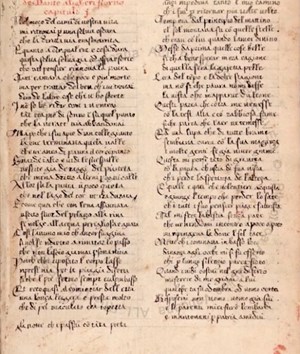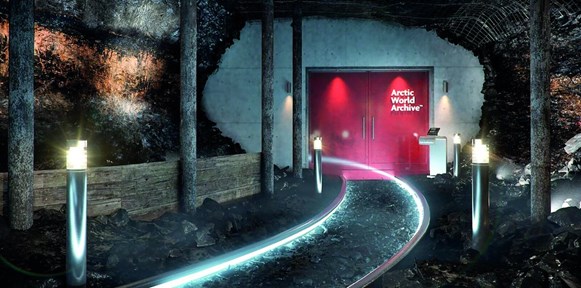
To celebrate 2018 as the European Year of Cultural Heritage, Piql will preserve the top ten European cultural relics in the Arctic World Archive, for the following 500 years. These relics will join existing treasures such as digitised manuscripts from the Vatican Library and Edvard Munch’s The Scream.
Image: La Divina Commedia by Dante Alighieri, 1308-1320, the fragment
To celebrate 2018 as the European Year of Cultural Heritage, Piql will preserve the top ten European cultural relics in the Arctic World Archive, for the following 500 years. These relics will join existing treasures such as digitised manuscripts from the Vatican Library and Edvard Munch’s The Scream.
ArtDependence Magazine asked Maurizio Tuccio, CEO of Piql Italy about present and future of art preservation.
Art Dependence Magazine (AD): Maurizio what is Piql?
Maurizio Tuccio (MT): Piql AS was established in Drammen, Norway, in 2002. A team of people with backgrounds in digital imaging founded the company and now it has a growing network of partner companies and offices around the world. Piql Italia is one of them, and it is based in Rome. Piql’s vision is to reshape data preservation, on a global scale.
AD: When did the idea of digitising artworks emerge, and what were the reasons?
MT: Most of the museums and art galleries worldwide have already begun digitising their documents and works of art in order to make them available to the public through new technologies and multimedia digital platforms, as well as to preserve them from potential destruction. However, digital is not as future-proof as it may seem, as digital data can be corrupted and potentially lost forever in the future.
The idea of creating a system capable of avoiding this risk-of-loss arose after the publication of the report “The Digital Dilemma” by Mary Clarke, which addresses the challenges relating to securing long-term access to the motion picture industry’s valuable assets; its movies. Actually, this was and is still a big issue concerning other sectors where digital data need be preserved. The art sector is one of them.
 Image: from left: Maurizio Tuccio, CEO of Piql Italy, His Excellence Most Reverend Jean-Louis Bruguès, Archivist and Librarian of the Holy Roman Church, and Mr. Cholanat Yanaranop, President of SCG Chemicals.
Image: from left: Maurizio Tuccio, CEO of Piql Italy, His Excellence Most Reverend Jean-Louis Bruguès, Archivist and Librarian of the Holy Roman Church, and Mr. Cholanat Yanaranop, President of SCG Chemicals.
AD: Please describe the Piql process step by step?
The Piql system was created as a response to the following challenge: most storage mediums have a limited lifetime, and hardware, software and file format technologies may become outdated after a period of time. The best practice so far, has been to work around the core of the problem, by committing to a never-ending cycle of necessary data migrations. The migration process is nevertheless costly and comes with its own risks; can be corrupted or lost during migrations.
We write digital bits and bytes onto piqlFilm, a special film with a proven longevity of a minimum of 500 years. We converted film into a digital storage medium, and combined its well-documented preservation qualities with the accessibility enabled by operating within a standard IT infrastructure. PiqlFilm is a self-contained medium that includes Archival File System Format (AFS), designed to contain metadata, written in human legible text, and which explains in detail how to recreate and regenerate the information on the film.
The following is the process:
Data can be stored in computer-readable digital format or as human legible text or images.
The optical qualities of film enable the unique combination of data storage and human readable information in one storage medium. In a disaster recovery scenario, one can simply read on the film how to retrieve the data – all one requires is a light source, a magnifying glass and a computer.
AD: Who are your clients? Which museums and galleries do you work with? What are the most popular and important pieces of art and documents stored that you may disclose?
MT: Our clients are data owners that belong to any segment of the marketplace including cultural heritage, such as museums, galleries, and cultural and art foundations.
Regarding the preservation of art in the future, Piql AS, through its worldwide partner companies, has already worked with numerous institutions to preserve their treasures for future generations. These include the Norwegian National Museum, holding Norway’s most extensive art collection including masterpieces such as The Scream, by Edvard Munch, of which a digital copy is now preserved in Piql's Arctic World Archive, and the National Museum of Brazil, which has already deposited part of its digitised collection in the Arctic World Archive. Piql is also in dialogue for the digitisation and preservation of pieces of art with the Contemporary Art Museum of Barcelona (MACBA), Picasso Museum of Barcelona, Maritime Museum of Barcelona, Thyssen-Bornemisza Museum and the Reina Sofia Museum in Madrid. They have agreed upon a collaboration that entails the preservation of digitised paintings, books and digital born arts.

La Divina Commedia by Dante Alighieri, 1308-1320, the fragment
Piql Italia is proud to have among its prestigious clients Fratelli Alinari and the Biblioteca Apostolica Vaticana (BAV).
Fratelli Alinari, the oldest photo archive in the world, will preserve an important number of their digitised images with Piql; masterpieces of the Italian cultural heritage, some of which are already deposited in the Arctic World Archive.
The Vatican Library has signed an important agreement of collaboration with Piql Italia for the preservation of their oldest and most valuable manuscripts and documents. A digitised old manuscript of La Divina Commedia by Dante Alighieri already lays in the Arctic World Archive.
AD: How did the Vatican become your client?
MT: The Vatican Library was already digitising most of their valuable art pieces and documents, and was searching for a technological solution to preserve its digitised treasures long-term. BAV's CIO was introduced to the Piql system and after a short time he deemed it the perfect solution to meet their requirements. They decided to entrust Piql Italia with the long-term preservation of some of the documents and manuscripts in their library. An initial part of this project has been accomplished recently. Piql Italia is now in discussion towards realising future projects.
AD: Where are these pieces of art and manuscripts preserved?
MT: Clients can decide to preserve their digital data in a location of their choice, on a site managed by Piql, or to deposit their data in the Arctic World Archive in Svalbard. They may even decide to buy the system (the writer and/or the reader machine), in order to operate autonomously in both the data writing and retrieving processes.

Arctic World Archieve in Svalbard
AD: Why was the Arctic region chosen? What are the conditions of preservation?
MT: Data is stored offline, out of the reach of cyber-attacks, in a disaster-proof vault in one of the most geopolitically secure places in the world, the Arctic Archipelago of Svalbard. No electricity or other human intervention is required as the climatic conditions in the Arctic are ideal for long-term archival of film.
AD: What is the role of Piql in preservation process?
MT: By keeping data offline on a future-proof storage medium, we help clients to safeguard their irreplaceable information; a unique and ultra secure turnkey solution. We receive data, and then convert them in binary code and encrypt them onto the piqlFilm to be stored. Data can be retrieved at any time in the future.
AD: What is the role of government agencies, are they in charge of the preservation of their national treasures?
MT: Most governments throughout the world are promoting specific programmes for the preservation of their national cultural heritage and various forms of art. Piql Italia is also operating with this perspective and is working to set up agreements with institutions, museums, galleries and film archives for the preservation of different works of art, which are the embodiment of the Italian cultural heritage. The other Piql partners are doing the same in their respective countries.
In the film industry for example, the Italian government have determined specific rules and regulations that direct film library owners to guarantee the long-term preservation of their movies that most represent the Italian cultural heritage. Piql Italia has already carried out the preservation of various paramount digital movies belonging to a number of private Italian film companies, such as Il Postino by Michael Raderford, Fabiola by Alessandro Blasetti, Lo Chiamavano Jeeg Robot by Gabriele Mainetti, and will also preserve masterpieces such as Bicycle Thieves by Vittorio De Sica, and Mediterraneo by Gabriele Salvatores.
 Arctic World Archieve in Svalbard
Arctic World Archieve in Svalbard
AD: What is the future of preservation for artworks?
MT: Alternate to the traditional ways of preserving original artworks, digitisation provides a way to guarantee both a wider access for the public and a higher level of preservation through new technologies and digital platforms. In addition, multimedia devices can offer the public the possibility of experiencing art in a fresh, exciting and vivid way.
However, paradoxically, being digital does not guarantee true long-term preservation. It had been proven that digital data suffer corruption and even destruction or partial loss after certain periods.
The Piql system offers a one-of-a-kind approach to avoiding this risk. The choice of the Vatican library, possibly the largest most important archive in the world, of entrusting Piql with the preservation of its own art masterpieces can be seen as a clear, eminent and influential message to all the other archives; a new path must be taken towards the secure preservation of artworks on a long-term basis.

ArtDependence Magazine is an international magazine covering all spheres of contemporary art, as well as modern and classical art.
ArtDependence features the latest art news, highlighting interviews with today’s most influential artists, galleries, curators, collectors, fair directors and individuals at the axis of the arts.
The magazine also covers series of articles and reviews on critical art events, new publications and other foremost happenings in the art world.
If you would like to submit events or editorial content to ArtDependence Magazine, please feel free to reach the magazine via the contact page.